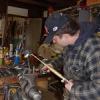All Activity
- Past hour
-

why did my angle grinder stop working
Dogsoldat replied to GhostTownForge's topic in Grinders, Sanders, etc
I've had switches and brushes fail. Also something to check is if the wire in the cord is broken. Most likely spot is right where it is pinched entering the body of the grinder. - Today
-

why did my angle grinder stop working
GhostTownForge replied to GhostTownForge's topic in Grinders, Sanders, etc
is there a possibility that the shut-off switch malfunctioned? because I had only been using the grinder for a few minutes. -

Champion #1 Power Hammer
Francis Trez Cole replied to MRB's topic in Power Hammers, Treadle Hammers, Olivers
I to have a 65lb #1. Philip I wrote an whole page on the adjustment of the head distance as well as up keep. I have been using mine for 15 years. Love it. it may be the angle your are shooting from but it seems that your spring is off center. If not the spring could be the adjustments on the hammer guide. Info from other users The only place you should not oil is on the drive belt surface area. One main thing to do. Make sure the toggle arms. The four arms that conect the ram to the spring arm, are drawn up so they are almost level. Not level. About 3/4" slop. you can measure this by holding a straight edge across the pins holding the arms at the spring, and the main pin through the ram should be about 3/4" of an inch below the straight edge. Play with this to find the optimum stroke for your hammer. This will also be affected by how far down you set the whole ram and spring arm assembly. To start tunning I would set that halfway with the double set screw holding the main pin. Going back to the toggle arms. If they are too sloppy, the hammer will skip or double hit. When they are too tight you stand a good chance of snapping the toggle arm at the spring pin junction. One other member recomended not over driving the bottom die wedge. RIGHT ON! My hammer was repaired due to this long before I got it. It is much better to re tighten the wedges every so often than to crack that front piece out. When mine was repaired they set the cracked piece back in place, drilled and tapped for three 3/4" bolts, bolted the 3 bolts after that, then they ground a V all the way around the 3 outside planes and welded it. I have had no problems with it, but I baby it there. As for other suggestions make sure the arm pins fit well in the spring arm holes. Where the spring wraps around the pin. Those pins should be no more than a 1/16" smaller than the spring holes. If they are sloppy the hammer won't hit right. One of the #0's I tunned had like 1 1/4" pins in a 1 3/4" hole. WAY to sloppy. The dovetail ways should be a little looser than you might think. Very scientific sounding, I know. But the best thing to do with them is after you have the hammer up and running. Move them in and out with the set screws until they are snug but not so snug as to stop the ram mid way in its stroke. That Champion is in super shape. The guides are like new in the thing and with that overhead jackshaft it should give very nice control. One thing that was wonky on that hammer was the brake did not engage when the treadle was up, It might return back to where it should be one the motor is in place and under tension. What I would do with that hammer is carfully scribe the outline of the smaller die onto the bigger die and then take them into a machine shop that can mate them up and flatten them out. I would do a combination style die with the fuller at front. if you change the motor its pretty critical to get the speed right so take note of the pulley diameter on that 5 horse. I ran my last one with a 110V 1.5HP motor and it worked perfectly. If it was going to be in severe use I would step up to a 2HP Once you get it timed right, the brake engaging and the toggles adjusted that hammer should give you single blow capability. One thing that will help down the road is make your self up a set of wood blocks to set the working hight of the upper die. at rest you want that die to be about a 1/8 above the thickness your working for the best control and hardest hit. I kept mine adjusted so when you rolled the machine over by hand the upper die would come within about 1/4" of the lower die and I didnt move it up until I got over 3/4 stock unless I was going to do real fine work.. should clarify in the earlier post about setting the die position... that 1/4 clear between the die is with the crank on its lowest possible position on the flywheel and with the toggle arms pulled good and tight on the spring and a very well adjusted hammer... Most hammers with a little slop in them you would need more like 3/4 of a inch to get a solid wack but yet have a light touch... and thats if your forging 1/4 or 3/8 stock... if your forging 1" bar you would need more like 1 3/4 clear at idle and the lowest position... Thats one of those things that really impacts performance and you just need to play with your hammer to see what works best... start with half a dozen 5/8 or 3/4 square bars that are a foot long with a center punch mark at 8" ( if you dont want to hold it with tongs make them as long as you want I guess) get them all up to temp and consistently forge out as long of taper as you can in one heat from the center punch mark... make an adjustment and go to the next one.... listen to how and where in its stroke the hammer hits and how hard of blows it lands... and it it is double tapping or missing a beat (way out of tune) its surprising how drastic of change you can get... also it will show you directly what your adjustments do Also I said I would do combo dies on that hammer and the only reason for that is because unlike a little giant the center of the tup weight is centered in the skinny of the die so working on either end has much less of a negative effect on the hammer.. and since it sounds likely this will be your primary hammer and its relatively small ( but capable ... a 65lb Champion that is well tuned will almost do the work of a run of the mill 100lb little Giant though) its sure nice to have fullering dies to quickly break down material and blend transitions..... If you have any questions Id be happy to help... I have owned two #1's and done some pretty major work on them including pouring new bearings in one.... oiling use SAE 30 for all contact points After doing a lot of research the original dies had three round swedges in the die 1/4”-3/8”-1/2” one of my dies had been refaced with hard facing rod and the swedges were filled in so I opted to fill in the top die as well and make all my tools clamp on to the bottom die. Like Clay Spencers method. Makes changing out fast I use a C clamp with a piece of angle iron as the base to all my tools so far I am pleased with how it works, -

why did my angle grinder stop working
Frosty replied to GhostTownForge's topic in Grinders, Sanders, etc
It over heated. Cut off disks require a LOT more power than grinding or sanding so unless you have a light touch the motor gets hot. When an electric motor reaches a set temperature it shuts off until it's cooled below the limit. Frosty The Lucky. -
That's pretty cool though I don't think unusual for mice. Buy better tasting tools maybe? Frosty The Lucky.
-

why did my angle grinder stop working
GhostTownForge replied to GhostTownForge's topic in Grinders, Sanders, etc
update: now it works. I poked around the switch mechanism, and now it works somehow. i would still like to know why it stopped working -
What did the Math book say to the English book? ”I’ve got problems.” Oh wait, you said good joke. Apologies.
-
When we lose track, a good joke is always appropriate
-
why did my angle grinder stop working
Jimw3326 replied to GhostTownForge's topic in Grinders, Sanders, etc
I just answered you on the blade forum. Haha! Brushes probably. - Yesterday
-
I can't argue. I'm losing track of what point we're on at any given moment and re-reading half a dozen posts is making my headache worse. I'll check back in in a couple days, we've run into Anchorage and back twice so far this week on top of other stuff and I'm shot. Frosty The Lucky.
-
As the practical choice, I must agree. However, I don't see many people, who aren't familiar with blacksmithing choosing it over a clean burning gas forge, these days
-
GhostTownForge started following why did my angle grinder stop working
-
I was cutting some steel and stopped for a second to adjust the extension cord, then when I tried to start again, the grinder had stopped working. I tried other things on that extension cord, and it worked fine. I checked some wires in the grinder, and nothing seemed out of place. please help
-
Okay, it does not begin to compare with a single burner Mister Volcano forge, which costs the same price; that is quite true. On the other hand, how much longer will the better forge continue to be offered? They have already taken their burners off the market. If we scoff at every other low cost forge, maybe there will be even fewer choices down the road? I look at that forge, and see how people who are reluctant till build their own forge can improve it, with little effort. Is it very small? Yes; on the other hand, people build coffee-can forges, and the even tinier two-brick forges, all the time, to build, repair, and change hand tools, and jewelry tools too.
-
I think there is a video of a mouse putting tools away. If I remember right, the guys tools he left on the work bench kept ending up in his toolbox over night when he was sure he had left them out. He ended up setting a camera up and caught video of a mouse putting them in the box. Ok so I just looked it up and had remembered a bit wrong, it was just stuff from a parts tub. But hey, Id love if my mice did this for me instead of chewing things up.
-
I didn't see a 2 burner version, I was commenting on the forge pictured above. Helpful? . . . Helpful? . . . Okay, it will be a safe place to burn a mosquito coil when you're propping the door open. Frosty The Lucky. I didn't see a 2 burner version, I was commenting on the forge pictured above. Helpful? . . . Helpful? . . . Okay, it will be a safe place to burn a mosquito coil while it's propping the door open. Frosty The Lucky.
-
Nick T joined the community
-
My first burner designs used a series of holes in a line. The famous Hybrid burners, changed those series of hole to slots, improving burner performance. I came back with rectangular air openings, with beveled edges for and aft, improving them still further. However, simply cutting out the material between the back and forward hole in these burners, will turn them into air slots, which should improve burner performance more than enough for small burners. So, what has size got to do with anything? For some reason that I do not understand, smaller burner sizes tend to run hotter than larger burners; I have had to partially de-tune my smallest burners (1/4" size and under), in order to maintain long turn down ranges. This is the main reason that I am playing with linear burner designs again; they are more than hot enough to serve as miniature burners, and a whole lot easier for people to construct than Mikey burners. Don't worry, though; I've already designed souped-up linear burner versions, which are much harder to build, for the determined hobbyist. Never let it be said, that I let my fellow mad scientist types down
-
"It is kind of odd but being in a war is both some of the best memories of my life and some of the worst. " Billy, truer words were never spoken/written. The other odd thing is how fresh the good and bad memories remain. Some of my memories of Viet Nam feel like they are only a couple of years old when, in reality, they have been in my head for over half a century. And memories of smells and tastes remain very clear. The memory of the taste of C rations or LRP rations (Long Range Patrol rations, freeze dried) is like something I ate a few days ago. GNM
-
Pick My Online Class changed their profile photo
-
I would lose the brick, and add a 1/4" thick finish flame surface of Kast-O-lite 30, or Plistix 900, instead. This is a much better forge than the one I looked at; not because of its size, which is better because you will want to keep it, even after you build the "forge of your dreams." The best improvement over the other one, is that there is no angle around its exhaust openings to heat up, and be warped out of shape As to providing parts for other forges...if you simply scribe lines between the forward and aft holes on its burner, I think you will decide to keep your "garage heater" just as is People might use the e-cowlboy forge for a fancy door stop? Let's not forget to be helpful, at all times
-
Pick My Online Class joined the community
-
I forgot about the split brick but that's generally my advice about putting a brick in the forge. Forget about it. Like Mike I see so little right about this forge I don't have to "Find" fault. Even the hose is pretty useless being crimped to whatever the "regulator is." One of the guys up here bought one and we discovered the regulator was nothing but a flashy needle valve and did nothing for psi. My best advice is, "Do NOT waste money on it!" It is so badly designed and built I'd be hard pressed to think of anything to use it for. Maybe hardening short blades one at a time. I'd rather build a charcoal fire in the old BBQ. Frosty The Lucky.
-
Good Wonder Billy. I think it's just the thing to let the experienced trainers figure out. Frosty The Lucky.
-
Wonder if they could be trained to put my tools away in the shop?
-
Reindeer, welcome aboard. My dad was a combat engineer in Vietnam. He was a heavy equipment operator, later went artillery. I chose the route of my granddad and road a tank around the ME. The Bedouins used to come running up to our tanks wanting food and water when i was there. We had one guy come looking for medical attention for his wife. While one of our guys was bandaging up her foot the husband tried to give me and a couple other guys his daughter. Not to "use" but the take back to the states with us. It is kind of odd but being in a war is both some of the best memories of my life and some of the worst.
-
Just rethought about that math, because math is awesome. You also have to subtract the volume of the split brick (another 50 in³). I get approximately 80 in³ if another layer is added, and the brick is included. The fit of the brick would be interesting too. Might have to cut it down or chamfer the edges. Would be even less volume if refractory is applied.
-
Al Bawadi Metal Industries joined the community
-
I use ¼ inch OD stainless brake line with my orifices. Used to be mig tips, now I use 3D printer nozzles. I turn the threads off and silver braze them in. Also, as usual, my math mostly agrees with Frosty’s.
-
You might want to refigure the volume. As shown I see 283 cu/in volume and if you ad another inch of ceramic wool barely 125 cu/in. The measurements shown are the outside dimensions you have to calculate volume with the inside dimensions. Frosty The Lucky.


